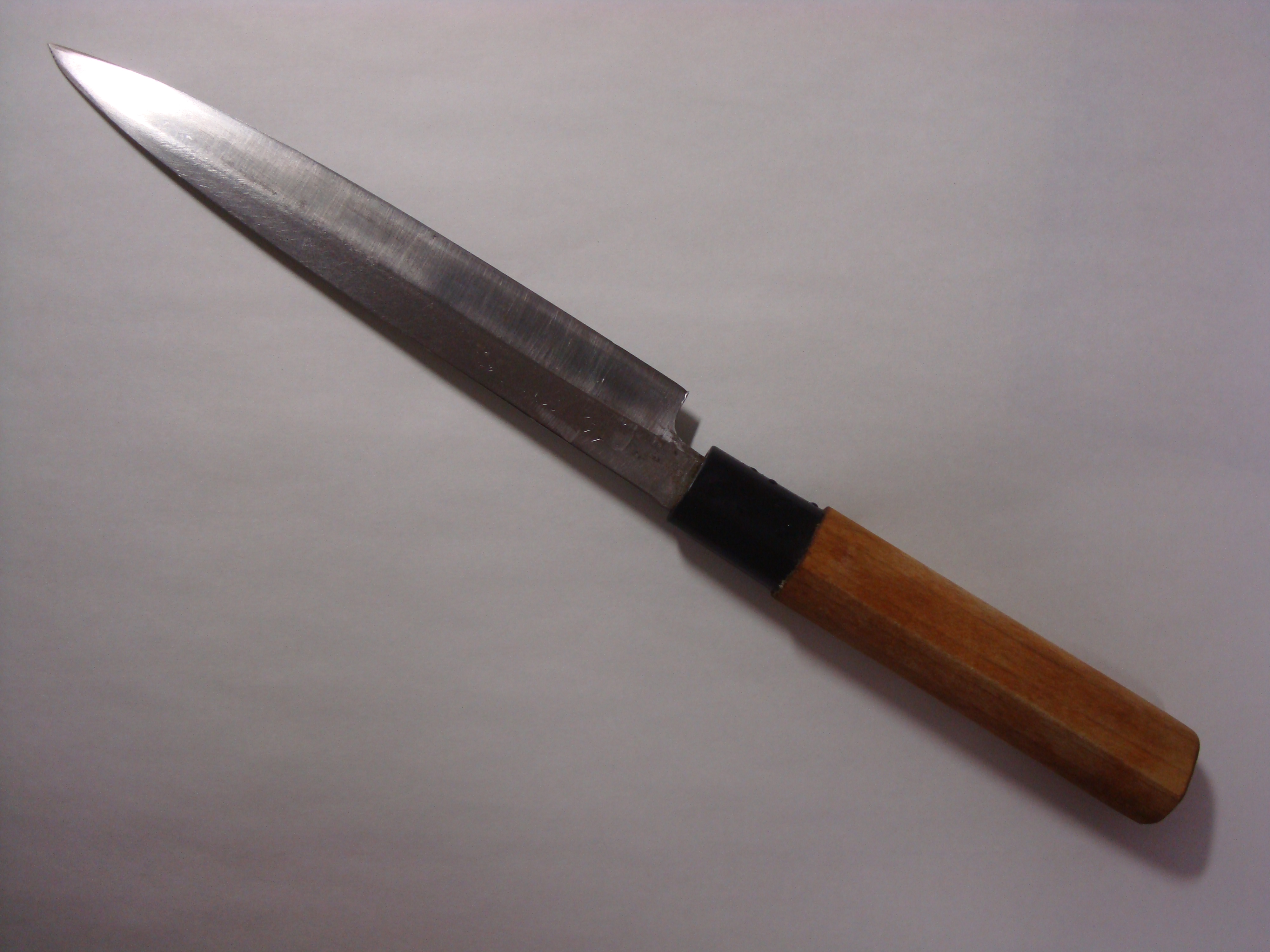yanagi ba on:
[Wikipedia]
[Google]
[Amazon]


 ''Yanagi-ba-bōchō'' (柳刃包丁, literally willow blade knife), y''anagi ba,'' or y''anagi'', is a long and thin
''Yanagi-ba-bōchō'' (柳刃包丁, literally willow blade knife), y''anagi ba,'' or y''anagi'', is a long and thin


knife
A knife ( : knives; from Old Norse 'knife, dirk') is a tool or weapon with a cutting edge or blade, usually attached to a handle or hilt. One of the earliest tools used by humanity, knives appeared at least 2.5 million years ago, as evidenced ...
used in the Japanese cuisine
Japanese cuisine encompasses the regional and traditional foods of Japan, which have developed through centuries of political, economic, and social changes. The traditional cuisine of Japan (Japanese: ) is based on rice with miso soup and other ...
. It is the typical example of the ''sashimi bōchō
Sashimi bōchō, literally "sashimi knife" is a type of long, thin knife used in Japanese cuisine to prepare sashimi (sliced raw fish or other seafood). Types of ''sashimi bōchō'' include , , and .
Similar to the ''nakiri bōchō'', the styl ...
'' (Japanese: 刺身包丁, sashimi aw fishbōchō nife used to slice fish for ''sashimi
is a Japanese delicacy consisting of fresh raw fish or meat sliced into thin pieces and often eaten with soy sauce.
Origin
The word ''sashimi'' means "pierced body", i.e. "刺身" = ''sashimi'', where 刺 し = ''sashi'' (pierced, stuck) ...
'' and '' nigiri sushi.''
When preparing ''sashimi'' and ''nigiri sushi'', the goal is usually to have cut surfaces that are smooth, shiny, and even in order to maximize the taste. The construction of a ''yanagi ba'' is designed for this purpose.
* Length: The long blade allows the user to cut a block of flesh in a single stroke. This prevents zigzag cutting, which creates a serrated cross section.
* Thinness: The blade is very thin behind the edge which allows the cut to be made using primarily the weight of the knife. Greater force or thickness would result in tearing or bruising of the flesh.
* Nonstick properties: The back face (''urasuki'') is concave to easily detach the blade from the substance being cut, and the front bevel (''shinogi'') allows sliced piece to be easily removed from the blade after cutting.
* Steel properties: The ''yanagi ba'' is crafted using techniques from those of the Japanese sword
A is one of several types of traditionally made swords from Japan. Bronze swords were made as early as the Yayoi period (1000 BC – 300 AD), though most people generally refer to the curved blades made from the Heian period (794 – 1185) to the ...
adapted to modern requirements. The blade is constructed from soft iron, which allows general toughness of the blade and ease of sharpening, laminated to high carbon steel
Steel is an alloy made up of iron with added carbon to improve its strength and fracture resistance compared to other forms of iron. Many other elements may be present or added. Stainless steels that are corrosion- and oxidation-resistant ty ...
, which allows hardness of the cutting edge and sharpness. The steel is typically Hitachi
() is a Japanese multinational corporation, multinational Conglomerate (company), conglomerate corporation headquartered in Chiyoda, Tokyo, Japan. It is the parent company of the Hitachi Group (''Hitachi Gurūpu'') and had formed part of the Ni ...
blue or white steel.
* Single ground: For right-hand use, the ''yanagi ba'' has a bevel on the right side and is concave on the left. This allows a more acute angle compared to most double bevel knives and nonstick properties.
* Cutting direction: While almost all western knives are used to push and cut, the ''yanagi ba'' is used pull and cut instead.
The first two characteristics are particularly for ''yanagi-ba-bocho'', and its name 'yanagi' is from long and pliant characteristics of a willow branch. The other characteristics are shared by all knives in Japanese cuisine.
The important principle in using a ''yanagi ba'' to prepare ''sashimi'' is not cutting down but ''pulling'' with its long blade in a single motion.
See also
*Japanese cutlery
Japanese may refer to:
* Something from or related to Japan, an island country in East Asia
* Japanese language, spoken mainly in Japan
* Japanese people, the ethnic group that identifies with Japan through ancestry or culture
** Japanese diaspor ...
*List of Japanese cooking utensils
The following items are common Japanese cooking tools used in preparing Japanese cuisine. For a list of general cooking tools see the list of food preparation utensils.
Knives
*''Deba bōchō'': kitchen carver for meat and fish
*'' Fugu hiki'', ...
References